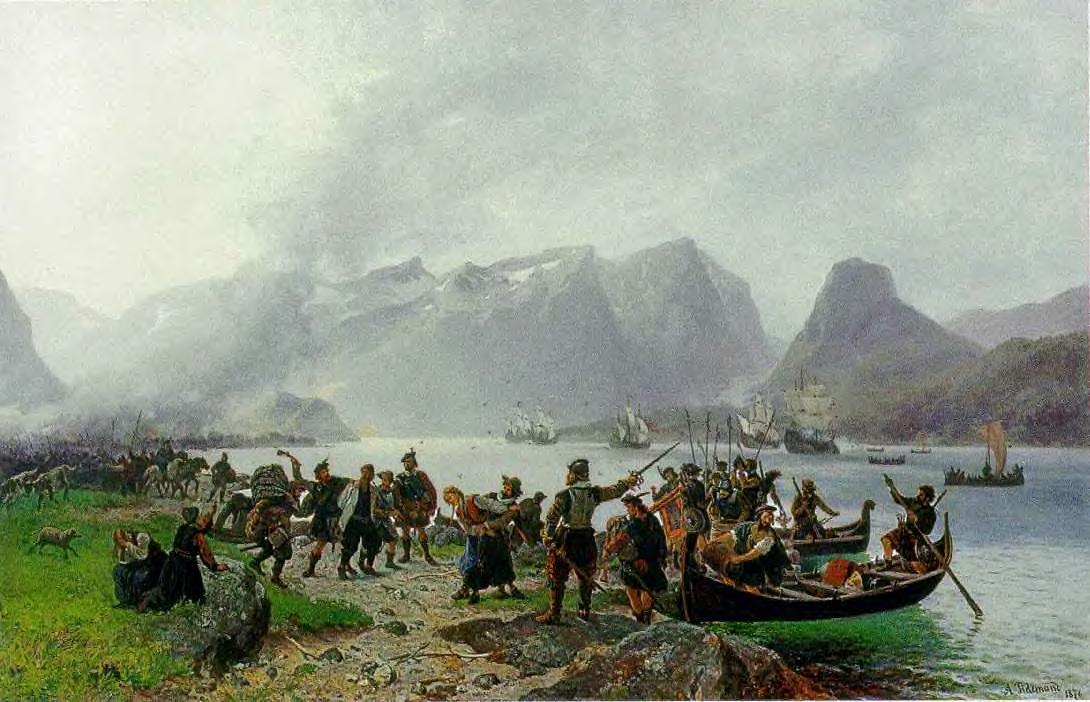‘Sinclair’s Ballad’ (or Zinklars Vise)
This a Norwegian song about the massacre of Scots mercenaries hired by the Swedish king in a war with Norway and Denmark. Colonel Alexander Ramsay and his men sailed from Orkney and landed at Isfjorden, on the coast of Romsdal and Møre, and were ambushed by Norwegian farmers at Kringen in the Gudbrandsdalen valley on 26 August 1612.
Many of the Scots were slaughtered, among them Captain George Sinclair, a natural son of David Sinclair of Stirkoke, a likely descendant of the earl of Caithness. George led the Caithness Company and tradition has it that he was shot by Berdon Segelstad with a bullet melted from a silver button. The place where he fell was marked with a wooden cross, and a commemorative plaque added in 1733. This lasted until an Englishman shot it to pieces with his pistol. A stone memorial was erected at the same spot on the 300th anniversary in 1912. There is a street named after Sinclair in nearby Otta, Innlandet county.
‘Zinklars Vise’ was written in 1781 by the Norwegian poet Edvard Storm (1749-94). Very little of his work has been published in English, so this version has been specially translated for our website by Louis Mackay (translator of Gerd Brantenberg’s The Daughters of Egalia), with help from some friends. Not all the words have simple English equivalents: ‘Herr Zinklar’, for example, means something between ‘Mr Sinclair’ and ‘Sir Sinclair’, so the translators decided that Lord Sinclair would work best. Interestingly, the original poem doesn’t refer to Sinclair as Captain Sinclair, just ‘Herr Zinklar’.
The poet and dramatist Henrik Wergeland (1808-1845) wrote an historical tragedy called Sinklars død (The Death of Sinclair) in 1828 and the composer Edvard Grieg (1843-1907) composed ‘Sinclair’s March‘ in 1880, the first of his four Norwegian Dances (Op. 35, No. 1 Allegro marcato), in honour of George Sinclair.
‘Zinklars Vise’ has been sung by several Norwegian groups: a traditional folk version by the 1970s group Folque, by Stormti in 1993, and a Viking metal version by Týr (2008). It was also sung by Gny at the Midvinterfestival, Den Grå Hal, Christiania, 2008, and by the Faroese group, Harkaliðið (2010). More recently by Hamradun (2019), and even dance versions, Klaksvíkar Dansifelag (2010) and below, Dansifelagið í Havn (2013).
‘Led er din Sang’ was composed by Kristian Blak and is sung here by the Faroese singer, Eivør Pálsdóttir, with kind permission (Yggdrasil: Tutl, HJF 88). You can also listen to ‘The Moorlough Shore’, sung by Sinéad O’Connor, referring to Sinclairs in County Tyrone, Ireland.
Sinclair’s ballad (Zinklars vise)
by Edvard Storm (1781)
Translated by Louis Mackay,
with Gabriele Haefs and Christina Bull
Lord Sinclair crossed the salty sea,
To Norway his course was set;
Among Gudbrand’s cliffs he found his grave,
Where a bloody brow awaited.
Up before the break of day,
They’re coming across the heath.
Lord Sinclair crossed the billows blue
For Swedish coin to fight;
God help you, for you surely shall
The turf of Norway bite.
The moon shines in the pale night,
The waves they gently roll:
A mermaid from the water rose
She bode Lord Sinclair ill.
Turn back! Turn back, you Scottish man!
At stake is your life so fair,
If you come to Norway, I tell you true,
You never shall return.
Wicked, your song, you poisonous troll!
Misfortunes you ever foretell,
As soon as I have you in my power
I’ll hack you limb from limb.
He sailed for days, he sailed for three
With all his hireling band,
On the fourth morning, he Norway saw,
That, I’ll not conceal.
On Romsdal’s coast he came ashore
Declaring his enmity;
With fourteen hundred men behind,
All with evil intent.
They pillaged and burned wherever they came,
They injured all they found,
The frailty of age, it moved them not,
They scorned the weeping widow.
The child was slain in its mother’s lap,
No matter how sweetly it smiled;
But tidings of this sorrow and woe
To the heart of the nation travelled.
The beacon flared and the messenger ran,
From each neighbour to the next,
The sons of the dale sought not to hide
As Lord Sinclair must avow.
The soldier’s away on the King’s campaign,
We must ourselves our land defend;
Cursèd be the worthless knave,
Who’d now his blood conserve!
The farmers of Våge, Lessøe and Lom,
With sharpened axes shouldered,
At Bredebøigd together came,
With the Scot, they would have words.
Just under Lide runs a path,
The people there call Kringen,
The company hastened past the place,
There the foe would fall.
On the wall no longer hangs the gun,
Yon grey-haired marksmen aim,
The water sprite lifts his dripping beard,
And longingly awaits his spoil.
The first shot did Lord Sinclair strike.
He roared and then his spirit yielded;
Each Scot cried out as their leader fell:
God free us from this woe!
Forward, farmers! Norwegian men, Advance!
Strike down, strike down and slaughter them!
Then longed the Scot for home again,
His lust for battle gone.
With corpses now was Kringen strewn,
The ravens ate their fill;
The blood of youth that here was spilled,
Scottish girls bewailed.
No living soul came home again,
To tell his countrymen,
How perilous it is to visit them
Who dwell among Norway’s hills.
Yet stands a column at the place,
That Norway’s foes would threaten.
Woe to any Norwegian unmoved,
Each time his eyes behold it!

Sinclair research by Peter Sinclair is licensed under a Creative Commons Attribution-NonCommercial-ShareAlike 4.0 International License.
Based on a work at https://www.sinclairgenealogy.info.





